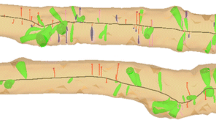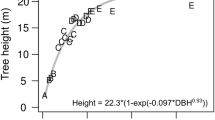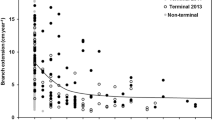Abstract
Epicormic branches can be a serious silvicultural problem in many Quercus species because of the potential reduction in log value associated with their occurrence. The phenomenon is also problematic for tree improvement since the genetic component of epicormic branching has not been well quantified. The strong influence of ontogeny on epicormic development in Quercus is well established; however, the long-standing assumption that genetic variation also influences epicormics has not been rigorously tested. With trees from two, 25-year-old Quercus alba L. progeny tests in IN, USA, we used computed tomography scanning to characterize internal epicormic development. We sampled trees from upper and lower crown classes of families that had been classified as having low, medium and high numbers of epicormic sprouts. We also measured an array of variables related to growth and competition with the objective of assessing the relative impacts of genetics and vigor on epicormic development. Using generalized linear and linear mixed models, we found that ontogenetic and vigor variables were strongly associated with epicormic structure and development, and that the genetic effect was negligible. The total number of epicormics was most significantly influenced by the number of sequential branches that bore epicormics (p < 0.001) and the proportion of undeveloped epicormics was most significantly influenced by diameter increment (p < 0.001). We propose that a strong focus on individual tree vigor and form in tree improvement could minimize the impact of epicormic branching in Q. alba trees.






Similar content being viewed by others
References
Alden T (1971) Seasonal variations in occurence of indole-3-acetic acid in buds of Pinus silvestris. Physiol Plant 25:54–57
Aloni R, Schwalm K, Langhans M, Ullrich C (2003) Gradual shifts in sites of free-auxin production during leaf-primordium development and their role in vascular differentiation and leaf morphogenesis in Arabidopsis. Planta 216:841–853
Bates D, Maechler M, Bolker B (2012) Package ‘lme4’: linear mixed-effects models using S4 classes. R package version 0.999999-0. http://cran.r-project.org/web/packages/lme4. Accessed 17 August 2012
Bolker BM (2012) Package ‘bbmle’: tools for general maximum likelihood estimation. R package version 1.0.4.1. http://cran.r-project.org/web/packages/bbmle/index.html. Accessed 17 August 2012
Bolker BM, Brooks ME, Clark CJ, Geange SW, Poulsen JR, Stevens MHH, White JS (2009) Generalized linear mixed models: a practical guide for ecology and evolution. Trends Ecol Evol 24:127–135
Bowersox TW, Ward WW (1968) Auxin inhibition of epicormic shoots in white oak. For Sci 14:192–196
Braham RR, Kellison RC (1987) Suppressed buds in yellow-poplar. J Elisha Mitch Sci S 103:47–55
Browne WJ, Subramanian SV, Jones K, Goldstein H (2005) Variance partitioning in multilevel logistic models that exhibit overdispersion. J R Statist Soc A 168:599–613
Büsgen M, Münch E (1929) The structure and life of forest trees, 3rd edn. Chapman and Hall Ltd., London
Carmean WH, Hahn JT, Jacobs RD (1989) Site index curves for forest tree species in the eastern United States. General Technical Report NC, vol 128. USDA Forest Service
Church TW, Godman RM (1966) The formation and development of dormant buds in sugar maple. For Sci 12:301–306
Colin F, Robert N, Druelle JL, Fontaine F (2008) Initial spacing has little influence on transient epicormic shoots in a 20-year-old sessile oak plantation. Ann For Sci 65:508
Colin F, Ducousso A, Fontaine F (2010a) Epicormics in 13-year-old Quercus petraea: small effect of provenance and large influence of branches and growth unit limits. Ann For Sci 67:312
Colin F, Mechergui R, Dhote JF, Fontaine F (2010b) Epicormic ontogeny on Quercus petraea trunks and thinning effects quantified with the epicormic composition. Ann For Sci 67:813
Colin F, Mothe F, Freyburger C, Morisset JB, Leban JM, Fontaine F (2010c) Tracking rameal traces in sessile oak trunks with X-ray computer tomography: biological bases, preliminary results and perspectives. Trees-Struct Funct 24:953–967
Colin F, Sanjines A, Fortin M, Bontemps JD, Nicolini E (2012) Fagus sylvatica trunk epicormics in relation to primary and secondary growth. Ann Bot 110:995–1005
Collet C, Colin F, Bernier F (1997) Height growth, shoot elongation and branch development of young Quercus petraea grown under different levels of resource availability. Ann Sci For 54:65–81
Dimov LD, Stelzer E, Wharton K, Meadows JS, Chambers JL, Ribbeck K, Moser EB (2006) Effects of thinning intensity and crown class on cherrybark oak epicormic branching five years after treatment. In: Conner KF (ed) Proceedings of the 13th Biennial Southern Silvicultural Research Conference. USDA Forest Serv Gen Tech Rep SRS-92. Asheville, pp 606–610
Fink VS (1980) Anatomische Untersuchungen über das Vorkommen von Sproß- und Wurzelanlagen im Stammbereich von Laub- un Nadelbäumen. I. Proventive Anlagen. Allg Forst Jagdztg 151:160–180
Fink VS (1983) The occurrence of adventitious and preventitious buds within the bark of some temperate and tropical trees. Am J Bot 70:532–542
Fontaine F, Druelle JL, Clement C, Burrus M, Audran JC (1998) Ontogeny of proventitious epicormic buds in Quercus petraea. I. In the 5 years following initiation. Trees-Struct Funct 13:54–62
Fontaine F, Kiefer E, Clement C, Burrus M, Druelle JL (1999) Ontogeny of the proventitious epicormic buds in Quercus petraea. II. From 6 to 40 years of the tree’s life. Trees-Struct Funct 14:83–90
Fontaine F, Colin F, Jarret P, Druelle JL (2001) Evolution of the epicormic potential on 17-year-old Quercus petraea trees: first results. Ann For Sci 58:583–592
Fontaine F, Mothe F, Colin F, Duplat P (2004) Structural relationships between the epicormic formations on the trunk surface and defects induced in the wood of Quercus petraea. Trees-Struct Funct 18:295–306
Gottschalk KW (1997) Stem quality of oak in 15-year-old stands: influence of species within harvesting treatment and fencing. In: Spiecker H, Rogers R, Somogyi Z (eds) Advances in research in intermediate oak stands. Institute for Forest Growth, Albert-Ludwigs-University of Freiburg, Freiburg, pp 85–97
Hardin JW, Hilbe J (2007) Generalized linear models and extensions, 2nd edn. Stata Press, College Station
Harmer R (1992a) Do dominant oaks have few epicormic branches? For Comm Gr Brit Res Div For Auth Res Inf Note 223
Harmer R (1992b) The incidence of recurrent flushing and its effect on branch production in Quercus petraea (Matt) Liebl growing in southern England. Ann Sci For 49:589–597
Harmer R (2000) Differences in growth and branch production by young plants of two provenances of Quercus robur L. Forestry 73:271–281
Heuret P, Guédon Y, Guérard N, Barthélémy D (2003) Analysing branching pattern in plantations of young red oak trees (Quercus rubra L., Fagaceae). Ann Bot 91:479–492
Jensen JS (2000) Provenance variation in phenotypic traits in Quercus robur and Quercus petraea in Danish provenance trials. Scand J For Res 15:297–308
Jensen JS, Wellendorf H, Jager K, De Vries SMG, Jensen V (1997) Analysis of a 17-year old Dutch open-pollinated progeny trial with Quercus robur (L.). For Genet 4:139–147
Kerr G, Harmer R (2001) Production of epicormic shoots on oak (Quercus robur): effects of frequency and time of pruning. Forestry 74:467–477
Kormanik PP, Brown CL (1969) Origin and development of epicormic branches in sweetgum. Research Paper SE, vol 54. USDA Forest Service
Kuser JE, Knezick DR (1985) Twenty-year observations on a clonal plantation of pitch pine in the New Jersey pinelands. Bull Torrey Bot Club 112:318–323
Longuetaud F, Mothe F, Leban JM, Mäkelä A (2006) Picea abies sapwood width: variations within and between trees. Scand J Forest Res 21:41–53
Longuetaud F, Mothe F, Kerautret B, Krähenbühl A, Hory L, Leban JM, Debled-Rennesson I (2012) Automatic knot detection and measurements from X-ray CT images of wood: a review and validation of an improved algorithm on softwood samples. Comput Electron Agric 85:77–89
Meadows JS (1995) Epicormic branches and lumber grade of bottomland oak. In Lowery G, Meyer D (eds) Proceedings of the 23rd annual hardwood symposium: advances in hardwood utilization: following profitability from the woods through rough dimension. National Hardwood Lumberman’s Association, Cashiers, pp 19–25
Meier AR (2012) Aspects of epicormic development in Quercus alba (L.) and other eastern North American oak species in relation to genetics, tree vigor and silvicultural treatments. MS Thesis, Purdue University
Meier AR, Saunders MR, Michler CH (2012) Epicormic buds in trees: a review of bud establishment, development and dormancy release. Tree Physiol 32:565–584
Miller GW (1996) Epicormic branching on central Appalachian hardwoods 10 years after deferment cutting. USDA For Serv Res Pap NE-702
Miller GW (2000) Effect of crown growing space on the development of young hardwood crop trees. North J Appl For 17:25–35
Miller GW, Stringer JW (2004) Effect of crown release on tree grade and DBH growth of white oak sawtimber in eastern Kentucky. In: Yaussy DA, Hix DM, Long RP, Goebel PC (eds) Proceedings of the 14th Central Hardwood Forest Conference. USDA For Serv Gen Tech Rep NE-316. Newton Square, pp 37–44
Morisset JB, Mothe F, Bock J, Bréda N, Colin F (2012a) Epicormic ontogeny in Quercus petraea constrains the highly plausible control of epicormic sprouting by water and carbohydrates. Ann Bot 109:365–377
Morisset JB, Mothe F, Chopard B, François D, Fontaine F, Colin F (2012b) Does past emergence of epicormic shoots control current composition of epicormic types? Ann For Sci 69:139–152
Morisset JB, Mothe F, Colin F (2012c) Observation of Quercus petraea epicormics with X-ray CT reveals strong pith-to-bark correlations: silvicultural and ecological implications. Forest Ecol Manag 278:127–137
Nicolini E, Chanson B, Bonne F (2001) Stem growth and epicormic branch formation in understorey beech trees (Fagus sylvatica L.). Ann Bot 87:737–750
Nicolini E, Caraglio Y, Pélissier R, Leroy C, Roggy JC (2003) Epicormic branches: a growth indicator for the tropical forest tree, Dicorynia guianensis Amshoff (Caesalpiniaceae). Ann Bot 92:97–105
O’Connor PA, Coggeshall MV (2011) White oak seed source performance across multiple sites in Indiana through age 16. In: Fei S, Lhotka JM, Stringer JW, Gottschalk KW, Miller GW (eds) Proceedings of the 17th Central Hardwood Forest Conference. USDA For Serv Gen Tech Rep P-78. Newton Square, pp 358–363
Okochi T, Hoshino Y, Fujii H, Mitsutani T (2007) Nondestructive tree-ring measurements for Japanese oak and Japanese beech using micro-focus X-ray computed tomography. Dendrochronlogia 24:155–164
Perkey AW, Wilkins BL (2001) Crop tree field guide: selecting and managing crop trees in the central Appalachians. USDA For Serv NA-TP-10-01
R Development Core Team (2012a) R: a language and environment for statistical computing, version 2.15.0. R Foundation for Statistical Computing, Vienna, Austria
R Development Core Team (2012b) Package ‘stats’: the R stats package. R package version 2.15.0. http://www.r-project.org/. Accessed 17 August 2012
Remphrey WR, Davidson CG (1992) Spatiotemporal distribution of epicormic shoots and their architecture in branches of Fraxinus pennsylvanica. Can J Forest Res 22:336–340
Rink G, Coggeshall MV (1995) Potential height gain from selection in a five-year-old white oak progeny test. South J Appl For 19:1–4
Ripley B, Hornik K, Gebhardt A, Firth D (2012) Package ‘MASS’: support functions and datasets for venables and Ripley’s MASS. R package version 7.3-17. http://www.stats.ox.ac.uk/pub/MASS4/. Accessed 17 August 2012
Schneider CA, Rasband WS, Eliceiri KW (2012) NIH Image to ImageJ: 25 years of image analysis. Nat Methods 9:671–675
Scrucca L (2011) Package ‘qcc’: quality control charts. R package version 2.2. http://cran.r-project.org/web/packages/qcc/index.html. Accessed 17 August 2012
Skaug H, Fournier D, Nielsen A, Magnusson A, Bolker B (2012) Package ‘glmmADMB’: generalized linear mixed models using AD model builder. R package version 0.7.2.12. http://glmmadmb.r-forge.r-project.org/. Accessed 17 August 2012
Spiecker H (1991) Controlling the diameter growth and the natural pruning of sessile and pedunculate oaks. Schriftenreihe der Landesforstverwaltung, Baden-Württemberg Band 72, Stuttgart
Ward WW (1964) Bud distribution and branching in red oak. Bot Gaz 125:217–220
Ward WW (1966) Epicormic branching of black and white oaks. For Sci 12:290–296
Wei Q, Leblon B, La Rocque A (2011) On the use of X-ray computed tomography for determining wood properties: a review. Can J Forest Res 41:2120–2140
Wetherill GB, Brown DW (1991) Statistical process control: theory and practice. Chapman and Hall, London
Wu R, Zeng ZB, McKeand SE, O’Malley DM (2000) The case for molecular mapping in forest tree breeding. Plant Breed Rev 19:41–68
Zellers CE, Saunders MR, Morrissey RC, Shields JM, Bailey BG, Dyer J, Cook J (2012) Development of allometric leaf area models for intensively managed black walnut (Juglans nigra L.). Ann For Sci 69:907–913
Zuur A, Ieno E, Walker N, Saveliev A, Smith GM (2009) Mixed effects models and extensions in ecology with R. Springer, New York
Acknowledgments
We would like to thank the Indiana Department of Natural Resources—Division of Forestry for access to the progeny tests from which plant material was obtained. In particular, we would like to thank Phil O’Connor for allowing us to use the white oak progeny tests in this study, and Dwayne Sieg at Harrison-Crawford State Forest and John Karstens at the Jasper-Pulaski State Tree Nursery for logistical support. Dr. Mark Coggeshall provided valuable insights into the history of the plantations. Jake Dyer, Daniel Moscosco and Sebastian Saenz helped with the installation of treatments and data collection. The log scanning portion of the project would have been impossible without the assistance of Dr. James Naughton and Donna Tudor at the Purdue University School of Veterinary Medicine. Finally, we would like to thank Drs. Charles Michler and Rado Gazo, and 2 anonymous individuals for reviewers of earlier versions of this manuscript. This project was funded by the Fred M van Eck Foundation for Purdue University, the Northern Research Station of the U.S. Forest Service, and the Hardwood Tree Improvement and Regeneration Center at Purdue University.
Author information
Authors and Affiliations
Corresponding author
Additional information
Communicated by R. Aloni.
Rights and permissions
About this article
Cite this article
Meier, A., Saunders, M.R. Assessing internal epicormic dynamics in Quercus alba L. using CT scanning: the strong effects of shoot development and tree growth relative to progeny level genetic variation. Trees 27, 865–877 (2013). https://doi.org/10.1007/s00468-013-0840-x
Received:
Revised:
Accepted:
Published:
Issue Date:
DOI: https://doi.org/10.1007/s00468-013-0840-x




